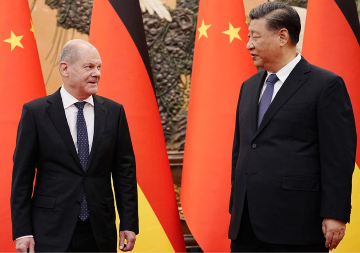
As the country is gearing up for the upcoming election on 8 November, Myanmar’s bilateral relations with India seems to have taken an upswing. Recent high-level visits and attempts to complete long-pending projects have breathed in fresh life into bilateral relations. The recent visit of India’s Foreign Secretary Harsh V. Shringla and Army Chief Gen M.M. Naravane on 5 October has been received quite well.
According to a few newspaper reports, the visitors handed over to State Counsellor Aung San Suu Kyi a consignment of drugs to treat Covid patients. In addition, India also announced the import of 150,000 tonnes of pulses from Myanmar till March 2021, and also a grant of $2 million for building a bridge at Byanyu-Sarsichauk in Chin state to ramp up economic connectivity between the north-eastern Indian State of Mizoram and Myanmar. Moreover, the Indian side proposed construction of a $ 6 billion petroleum refinery in Thanlyn area, near Yangon.
In geostrategic terms, it can be interpreted as India’s bid to strengthen bilateral ties when it is caught in a near-war situation with the common neighbour — China.
The visit aimed at reaffirming India’s commitment to bilateral relations through connectivity projects in Sittwe, joint production of Covid drugs and handling the issue of displaced Rohingyas in Bangladesh. The two sides also discussed coastal-shipping agreement that will allow Indian ships to reach Mizoram via Sittwe Port on the Bay of Bengal and through the Kaladan river multimodal link.
At the bilateral-level, the visit is seen as a balancing-act to secure India’s position in the domestic affairs of Myanmar, ahead of the elections. In geostrategic terms, it can be interpreted as India’s bid to strengthen bilateral ties when it is caught in a near-war situation with the common neighbour — China.
Increasing visibility
The strategic location of Myanmar is beneficial for India’s economic engagement as well as physical and social connectivity. It hopes to connect and develop India’s much neglected Northeast. In the past, the visibility of India has been lacking in this region in comparison to China. However, with the current wave of projects, the nation is bouncing back. Among few, New Delhi is assisting Myanmar in areas such as information technology, agriculture, and infrastructure.
A number of Indian companies have also set up operations in Myanmar, including oil and gas players like the ONGC Videsh and GAIL.
As of November 2019, in terms of investment, India stands at 11th position with an approved investment of $771.488 million by 33 Indian enterprises. Thirteen Indian Public Sector Undertakings have a presence in Myanmar in different sectors. Most of India’s investments have been in the oil and gas sector. Moreover, India has been developing the bordering areas under the India-Myanmar Border Area Development. During the end of August 2020, the latter has handed over $5 million for the third year of the agreement for the development of roads and bridges and schools undertaken in nine townships with 82 beneficial villages.
A number of Indian companies have also set up operations in Myanmar, including oil and gas players like the ONGC Videsh and GAIL. Banks such as the State Bank of India, United Bank of India now merged with Punjab National Bank, and the Exim Bank of India have opened representative offices. India’s Rupay is supposed to soon make an entry paving way for digital payment gateway.
At ease with all
India has tried to also keep the Tatmadaw, the powerful military opponent to the NLD, at ease. The Tatmadaw also understands the significance of India. This is evident during the strategic cooperation that began since 2019. The Myanmar army first drove ethnic rebels from Nagaland and other States in northeastern India from their main base at Taga in Myanmar’s northern Sagaing region. Satisfied by this, India has responded favourably by supplying the Tatmadaw with weapons that have helped in its fights with various insurgent groups. The bilateral relations witnessed new heights with the signing of the military agreement. More importantly, India has also agreed to train Myanmar army officers and allow them to study at military academies in India. In May 2020, the Myanmar government handed over 22 ethnic Assam rebels.
India has also agreed to train Myanmar army officers and allow them to study at military academies in India.
It is quite evident that Myanmar’s omnipotent generals are seeking the new player to counter-balance China’s rising influence in the country. In several media reports, it has been hinted that the nation is hesitant and suspicious of the intentions of China especially as they fear that the latter is facilitating the ethnic militant groups with advanced weaponry and technical knowhow’s which is apparently responsible for the successful resistance of the ethnic group and the ongoing fights between the Arakan Army (AA) and the Tatmadaw.
Rohingya issue
India has been seemingly tactful in discussing the issue of the hapless displaced Rohingyas in Bangladesh. While sympathising with the government, the former has nudged the latter to secure position for the displaced people within the country and to start the repatriation process soon in consultation with Bangladesh. To ensure that such process is indeed unfolded in recent future, India has laid emphasis on the socio-economic development of the Rakhine province to create enough economic incentive for the displaced people who will return from the camps at Bangladesh.
In this regard, Myanmar has appreciated India’s provision of 250 pre-fabricated houses and relief materials for displaced persons in northern Rakhine in 2019. Both sides agreed to expedite the implementation of a set of 12 projects under the second phase of the Rakhine State Development Programme and to further strengthen their development cooperation. This includes setting up a skills training centre, upgradation of agricultural mechanisation, etc.
Ignoring the needs of the ethnic or minority communities will not help in the long-run.
In addition, the visit of Myanmar President Win Myiunt and his wife to India in February 2020 and the MoUs signed were mostly focused on developing the Rakhine state. India’s intention may be two-fold in this:
First, a significant part of India’s Kaladan multimodal project (KMMTTP) passes through the Rakhine state which is engulfed in a war like zone between the AA and the Tatmadaw. 2019 has been filled with instances of the abduction of Indian workers while working in the Paletwa to Zorinpuri road stretch. There is a growing concern that this is arranged by the AA.
Although, in a coordinated operation with the Myanmar Army, almost 12 of the AA camps were claimed to be destroyed, it hardly seems to have acted as a deterrent for the insurgent group who are, if the newspaper reports are to be believed, being funded by China. Thus, apart from the other contingencies like cost and management, there is delay in the completion of the project. This has caused displeasure and has instilled the need to act with prudence.
Second, citing security concerns, India is unenthusiastic to allow Rohingyas to continue to live within its soil since the last few years. The push back approach in 2018 gained quite a number of glares from the international community. Thus, the only way to constructively address the issue will be to send them back to their place of origin or rather the Rakhine state. Thus, development of the region becomes essential.
While the upcoming election campaigns is essentially favouring those in power and partially neglecting the ethnic political parties, however ignoring the needs of the ethnic or minority communities will not help in the long-run. This fact has partially been recognised by those in power. Thus, while balancing its act, India needs to counterbalance the ethnic strife and bureaucratic lassitude from its end in future.
This essay originally appeared in South Asia Weekly.
The views expressed above belong to the author(s). ORF research and analyses now available on Telegram! Click here to access our curated content — blogs, longforms and interviews.




 PREV
PREV


